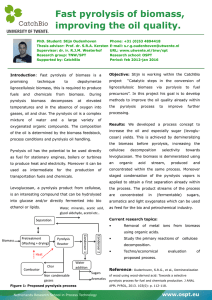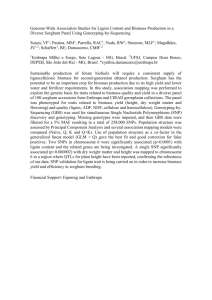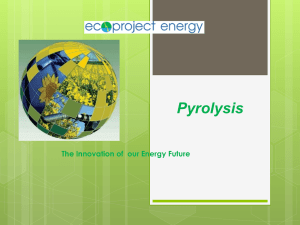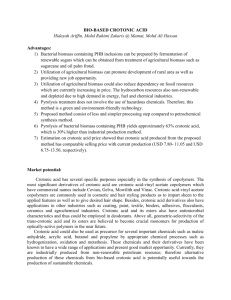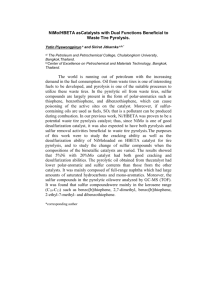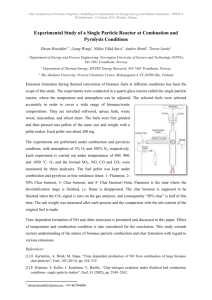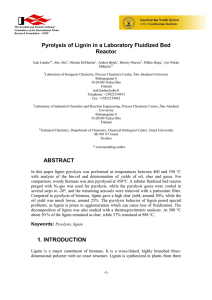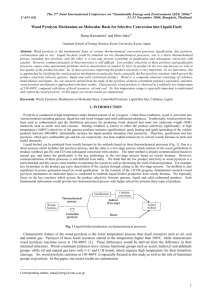Lit. Review - Multi-Scale Modeling and Simulation Laboratory
advertisement
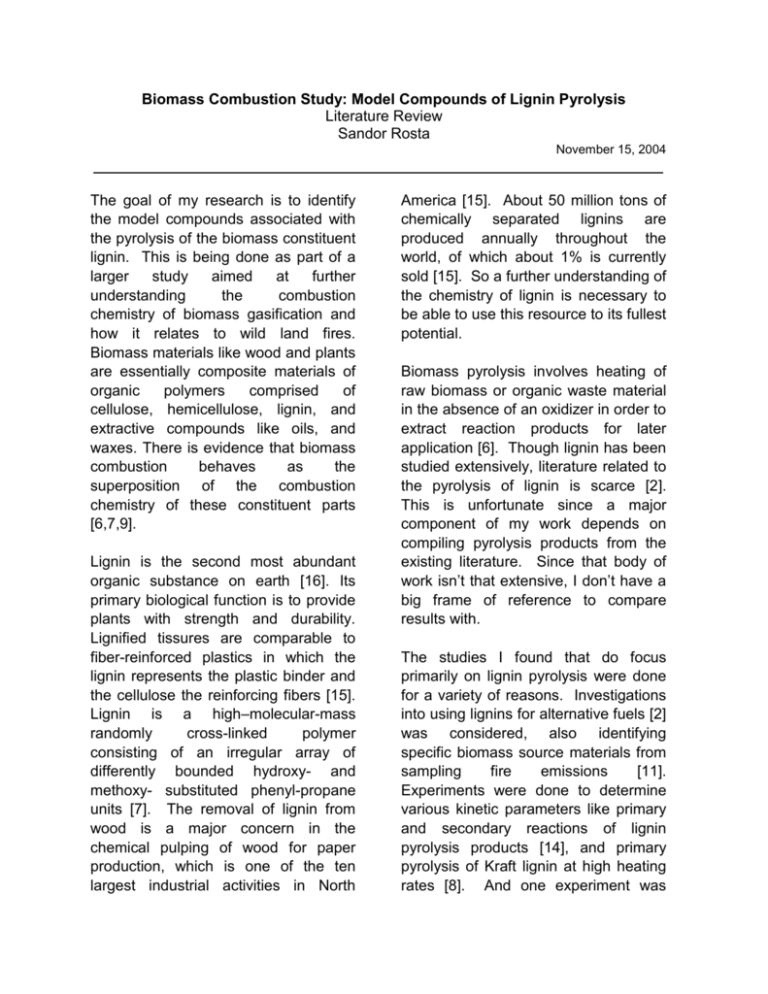
Biomass Combustion Study: Model Compounds of Lignin Pyrolysis Literature Review Sandor Rosta November 15, 2004 ____________________________________________________________________ The goal of my research is to identify the model compounds associated with the pyrolysis of the biomass constituent lignin. This is being done as part of a larger study aimed at further understanding the combustion chemistry of biomass gasification and how it relates to wild land fires. Biomass materials like wood and plants are essentially composite materials of organic polymers comprised of cellulose, hemicellulose, lignin, and extractive compounds like oils, and waxes. There is evidence that biomass combustion behaves as the superposition of the combustion chemistry of these constituent parts [6,7,9]. Lignin is the second most abundant organic substance on earth [16]. Its primary biological function is to provide plants with strength and durability. Lignified tissures are comparable to fiber-reinforced plastics in which the lignin represents the plastic binder and the cellulose the reinforcing fibers [15]. Lignin is a high–molecular-mass randomly cross-linked polymer consisting of an irregular array of differently bounded hydroxy- and methoxy- substituted phenyl-propane units [7]. The removal of lignin from wood is a major concern in the chemical pulping of wood for paper production, which is one of the ten largest industrial activities in North America [15]. About 50 million tons of chemically separated lignins are produced annually throughout the world, of which about 1% is currently sold [15]. So a further understanding of the chemistry of lignin is necessary to be able to use this resource to its fullest potential. Biomass pyrolysis involves heating of raw biomass or organic waste material in the absence of an oxidizer in order to extract reaction products for later application [6]. Though lignin has been studied extensively, literature related to the pyrolysis of lignin is scarce [2]. This is unfortunate since a major component of my work depends on compiling pyrolysis products from the existing literature. Since that body of work isn’t that extensive, I don’t have a big frame of reference to compare results with. The studies I found that do focus primarily on lignin pyrolysis were done for a variety of reasons. Investigations into using lignins for alternative fuels [2] was considered, also identifying specific biomass source materials from sampling fire emissions [11]. Experiments were done to determine various kinetic parameters like primary and secondary reactions of lignin pyrolysis products [14], and primary pyrolysis of Kraft lignin at high heating rates [8]. And one experiment was conducted to validate the use of pyrolysis-gas chromatography-mass spectrometry (Py-GC-MS) [5]. The most significant aspect of these studies to me, are the tables of pyrolysis products formed. It is known that the pyrolysis reaction of lignin is strongly influenced by temperature, heating rate, and the nature of the carrier gas. Also, the nature of lignin, its composition, and various functional groups have significant effects on the lignin, conversion, and product yields [2]. So, since the conditions under which these experiments have been done are different, comparing the results from each one and drawing conclusions about the most significant products is a non-trivial task. Another important factor in these pyrolysis experiments is the type of reactor used, and under what conditions. A fixed-bed reactor was used in [2] under and Kraft Lignin was heated from 298-1073 K. In [5] all analyses were performed using a CDS Pyroprobe 1000 heated filament pyrolyzer at 200 C and 290 C. Another Pyroprobe 1000 was used in [8] and heated up to 1000 C. In [11], the combustion experiments were carried out in a traditional brick fireplace in an older single-family home. No temperature was given about the fire, but the instrument analysis reports a temperature programming of injecting sample at 65 C and then heating at 10 C/min for 21 min and then holding at 275 C for 21 minutes. In [13] pyrolysis was performed with ferromagnetic wires having a Curie temperature of 510 C, held at 50C for 3 min, and programmed to 250 C at a rate of 3 C/min. In [14], stainless steel microtube bomb under heating conditions that are unclear. The string of continuity that runs through most of the experiments in the literature is the method of species detection. Pyrolysis thermally degrades polymers into small fragments which are separated by gas chromatography and identified with mass spectrometry [5]. [2,5,8,12,15,17]. Thermogravimetric analysis is also performed [2]. Since the literature results were somewhat limited to the topic directly related to my area, I broadened my search a little to include related topics. The methods used in [3] and [10] are very similar to methods used to study lignin pyrolysis, but they are focused on the cellulose compound. The represented data doesn’t explicitly apply to my study, but insight can be gained from their experimental methods. Also included are general biomass pyrolysis studies [4,6,7,9,12]. These studies consider all components of biomass including lignin. The problem with their reports is that they don’t account for all the species that each component breaks into, the just lump all the effects into lignin, or hemicellulose. They are useful though as precedence for what results should be obtained when the time comes to run simulations on the model compounds that I need to determine. 1. Brown, AL; Hames, BR; Daily, JW; et al. “Chemical analysis of solids and pyrolytic vapors from wildland trees” ENERGY & FUELS, 17, 1022-1027 (2003) 2. Ferdous, D; Dalai, AK; Bej, SK; et al. Pyrolysis of lignins: Experimental and kinetics studies,” ENERGY & FUELS, 16 (6): 1405-1412 (2002) 3. Brown, AL; Dayton, DC; Daily, JW, “A study of cellulose pyrolysis chemistry and global kinetics at high heating rates,” ENERGY & FUELS, 15 1286-1294 (2001) 4. Zhou, XY; Mahalingam, S, “Evaluation of reduced mechanism for modeling combustion of pyrolysis gas in wildland fire” COMBUSTION SCIENCE AND TECHNOLOGY, 171, 39-70 (2001) 5. Bocchini, P; Galletti, GC; Camarero, S; et al. “Absolute quantitation of lignin pyrolysis products using an internal standard,” JOURNAL OF CHROMATOGRAPHY A, 773 (1-2): 227-232 (1997) 6. Miller, RS; Bellan, J, “A generalized biomass pyrolysis model based on superimposed cellulose, hemicellulose and lignin kinetics,” COMBUSTION SCIENCE AND TECHNOLOGY, 126 97-137 (1997) 7. Alen, R; Kuoppala, E; Oesch, P, “Formation of the main degradation compound groups from wood and its components during pyrolysis,” JOURNAL OF ANALYTICAL AND APPLIED PYROLYSIS, 36, 137-148 (1996) 8. Caballero, JA; Font, R; Marcilla, A, “Study of primary pyrolysis of Kraft lignin at high heating rates: yields and kinetics,” JOURNAL OF ANALYTICAL AND APPLIED PYROLYSIS, 36, 159-178 (1996) 9. Raveendran, K; Ganesh, A; Khilar, KC, “Pyrolysis characteristics of biomass and biomass components,” FUEL, 75, 987-998 (1996) 10. Antal, MJ; Varhegyi, G, “Cellulose Pyrolysis Kinetics - The Current State Knowledge, “INDUSTRIAL & ENGINEERING CHEMISTRY RESEARCH, 34 703717 (1995) 11. Simoneit, BRT; Rogge, WF; Mazurek, MA; et al. “Lignin Pyrolysis Products, Lignans, and Resin Acids as Specific Tracers of Plant Classes in Emissions from Biomass Combustion,” ENVIRONMENTAL SCIENCE & TECHNOLOGY, 27 2533-2541 (1993) 12. Evans, RJ; Milne, TA, “Molecular Characterization of the Pyrolysis of Biomass .1. Fundamentals,” ENERGY & FUELS, 1 123-137 (1987) 13. Saizjimenez, C; Deleeuw, JW, “Lignin Pyrolysis Products - Their Structures and Their Significance as Biomarkers,” ORGANIC GEOCHEMISTRY, 10 869876 (1986) 14. Jegers, HE; Klein, MT, “Primary and Secondary Lignin Pyrolysis Reaction Pathways,” INDUSTRIAL & ENGINEERING CHEMISTRY PROCESS DESIGN AND DEVELOPMENT, 24 173-183 (1985). 15. B. L. Browning, “The Chemistry of Wood”, Interscience Publishers, London, (1963). 16. Glasser W. G., Northey, R. A, Schultz, T. P., “Lignin: Historical, Biological, and Materials Perspectives”, ACS Symposium Series 742, American Chemical Society, Washington D. C. (2000)

